André Klein's Blog, page 19
November 13, 2013
Turn Your Research Paper Into A Book: 5 Reasons To Self-Publish Your Work

Recently, I stumbled over an old research paper I had written in university. The term paper (a short treatise on classical perceptions of melancholy as a disease of the “four temperaments”) had survived on a backup copy of my website, stowed away on a disused hard-drive. And surprisingly, as much as I had sweated over the paper back then, it now gave me great pleasure to read it.
For this one research paper that survived, many others which I hadn’t uploaded to my webpage didn’t survive. They were wiped away with accidental deletions or computer crashes. And I thought to myself, why didn’t you publish your other term papers on your website as well?
Back then, it wasn’t that that easy to self-publish digital or paperback books. Today it has become relatively easy to create an ebook from a research paper.
Here’s why it might be a good idea to turn your research paper into a book by self-publishing it:
1. Writing For Grades, Or Writing For the World
If you’re taking a course and you’re writing a paper about a topic that you’re keenly interested in, what is your motivation, really? It’s a lot of work. Why are you doing it? Only to get a grade, to pass the term, or because you want to participate in a discussion, collect research and link it in interesting ways?
Unfortunately there seems to be a common understanding among students that their term papers aren’t good enough for a wider audience. Of course, being a novice in a field should come with some modesty, but sometimes novices can make connections because they aren’t burdened yet with the knowledge of “what has been done”.
Naturally, many research papers we write don’t even interest ourselves; we do them compulsively. But once in a while we find a topic we’re burning for with a fiery passion. Whether it’s a historical figure, a novel from the 19th century, the work of an early scientist etc. — we feel that a topic resonates with us, and we yearn to share our own ideas and connections.
Since you’re already doing the work, from research to writing to editing to formatting, why not do the last bit, too, and publish it? Usually, after handing in a paper you’ll get it back with remarks and corrections. But what happens then? Why not integrate these suggestions, fix the errors and publish it?
In short: why write for the drawer if you can write for the world?
2. Reclaim Your Curiosity
Surely, many academics don’t encourage students to publish their early thoughts, but that’s not because these thoughts aren’t worthwhile, but because academia is a fortress heavily guarded by gatekeepers.
Your professor likely didn’t get to publish any of his papers until he jumped through a series of arbitrary hoops set up by those higher up the chain. So why should he encourage you to take a stand and say: “Hey, what I wrote here is interesting enough for publication!”
Academics usually publish their works in academic journals, which are often notoriously difficult to get into, especially if your opinion about a topic diverges from a widely accepted tradition or “school”. However, this is what often makes these journals so boring. There’s nothing new, no fresh insights unconstrained by the barriers of “prim and proper”.
Don’t let this world of preconceived notions bully you into thinking that your own research papers couldn’t possibly contain anything worth reading.
If you don’t take a stand for your own work, nobody will do it for you! Publish those research papers dearest to you and make them accessible to the whole world.
3. Learn About Publishing
Unfortunately, too many students today are only interested in passing the test, getting their grade as quickly as possible and then leave the world of research and writing behind them to get “a good job”.
But what if your field of study is too important to you to just hurry through? Perhaps you’d like to keep thinking about these topics, keep researching, collecting and connecting the dots, beyond the obligatory.
By self-publishing your term paper you can gain valuable insights into the publishing process. Even if no one will ever read what you published, you will have learned how to format and edit a manuscript and release it for digital publication.
You will improve your text-processing skills beyond the mandatory “double-spacing, 12pt Times New Roman” or whatever the style-guide demands. You will think about creative solutions to formatting and presentation of ideas in general.
Once acquired, nobody can take these skills from you. Perhaps you’ll use them one day to help publish a friend’s novel, work for an online magazine, or perhaps you’ll just keep honing your craft on your own and develop your own writing.
4. Contribute To Society
Young people are often told that they should become responsible adults who “contribute to society”. All too often, this contribution is vague and distant. Why not start when you’re still studying?
Maybe your research paper on Navigation-Related Structural Change In the Hippocampi of Taxi Drivers (this paper actually exists) will never gain mass-appeal or land you a book deal, but perhaps one day a person at the other end of the planet is looking for information about a very specific niche you just happened to write a paper about.
Admittedly, many student papers aren’t very original, but perhaps you still managed to put two pieces together in a way that sparks new ideas in someone else’s mind. Your paper doesn’t have to be perfect, but by self-publishing it in book format, it might become a seed for other works.
Maybe your modest student paper will not solve the Middle East conflict or cure cancer, but perhaps one day it will mean something to someone somewhere. Perhaps it won’t, but if you don’t make it available, we are never going to find out.
5. Put A Price On Your Research Paper And Sell it
Last but not least, there is always a chance that by taking your research paper and turning it into a book, someone will buy it. If one person buys it, finds it interesting and leaves a positive review, others might, too. You probably won’t get rich doing this, but many academic journals don’t have a huge readership, either.
If you self-publish your paper and put it on the Amazon Kindle store for example, you could price it as low as $0.99 cents and make 35% royalty on each sale. Or you could use Smashwords to distribute your work for free across a number of retailers.
All this process doesn’t cost anything (except your time and efforts). So what is there to lose?
For more information about the actual publishing process, see also my short tutorial series How To Create Ebooks With Open Source Software.
-
img: CCby Metro Transportation Library and Archive

 About the author:
André Klein was born in Germany, has grown up and lived in many different places including Thailand, Sweden and Israel. He has produced two music albums, performed and organized literary readings, curated an experimental television program and is the author of various short stories and non-fiction works.
About the author:
André Klein was born in Germany, has grown up and lived in many different places including Thailand, Sweden and Israel. He has produced two music albums, performed and organized literary readings, curated an experimental television program and is the author of various short stories and non-fiction works.
The post Turn Your Research Paper Into A Book: 5 Reasons To Self-Publish Your Work appeared first on Learn Out Live!.





November 4, 2013
Fed Up With German Articles and Gender? Let This Free Tool Fix Your Emails

Many people don’t appreciate the fact that English nouns have no gender until they come upon another language which does. French and Spanish nouns have both masculine and feminine gender, which is bad enough for most learners, but German learners have to put up with yet another one: the neuter.
Admittedly, it’s not as bad as Polish which has 5 genders, or Swahili, which sports a whopping 18 noun classes, but for most of us mere mortals, putting up with der, die, das on a daily basis is frustrating enough.
For example, it seems obvious that the word Bruder (brother) is masculine whereas Schwester (sister) is feminine. But why — in the name of the three-legged Goat of Grammar! — why is Mädchen (girl) neuter?
Before we now venture off into gender studies, I want to remind everyone of the distinction between biological gender and grammatical gender. In English, they share the same term, which makes for a lot of name-calling and holy wars in the name of “gender equality”. In German, the former is called Geschlecht, while the latter is called Genus. While there are some correlations, these are two separate phenomena.
Find the Right Articles Without A Dictionary
Recently, I stumbled over an interesting tool called Genusly. It promises to “help you write perfect emails by telling you the genus of the German nouns as you type”, and it’s free. Sounds too good to be true? Here’s how it works:
At the moment Genusly comes as free browser extension for Google Chrome. After installing the extension, Genusly will automatically color your German nouns while writing emails.
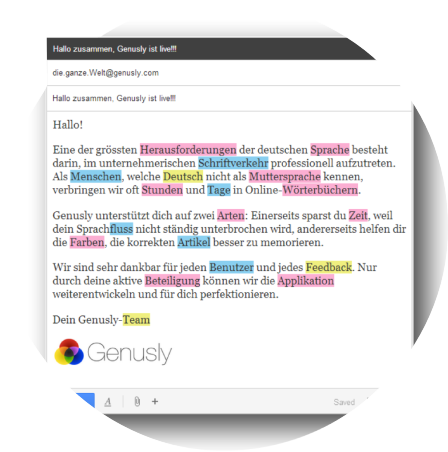
masculine is blue, feminine magenta, and neuter yellow
So, let’s say you’re writing a short note to a German friend. You don’t want to embarrass yourself by still using the wrong articles after many years of learning German (happens to the best of us) but also you don’t want to look up every single word in a dictionary. Genusly can help:

get Genus hints and fix your articles while you write
Simple & Free With Room For Improvement
After playing around with this tool for a while it seems that it could be a helpful tool for German learners. Unfortunately, it only works if you’re writing emails in your browser via Gmail, Yahoomail and Outlook.
According to the developers’ website, a downloadable version for Apple Mail and Outlook (desktop) is coming soon, but I think it could also be great to extend this tool’s functionality beyond email writing to Social Media.
Many language learners are using Twitter or Facebook these days to engage in practice and discussion, so this tool might come in handy while posting updates or comments.
What do you think? Can you imagine adding this extension to your German learning toolkit? Or is it too limited?
UPDATE: I just got an email from the guys over at Genusly and they told me that their web-version is now live. In other words, you don’t have to open your email, you can now go to genusly.com, type something in the box and have your nouns colored. Also, I was told that Facebook and Twitter integration are “in the pipeline”, so if you like this tool, stay tuned for further updates.
-
img credits: screenshot by genusly.com, photo by Rafael Peñaloza via flickr (CC)
Death By Gaming: A New Murder Mystery For German Learners
Of Swords & Dungeons: An Interactive Gamebook For German Learners
German Short Stories For Beginners
How to Learn German With Stories
5 Ways To Learn German For Free

 About the author:
André Klein was born in Germany, has grown up and lived in many different places including Thailand, Sweden and Israel. He has produced two music albums, performed and organized literary readings, curated an experimental television program and is the author of various short stories and non-fiction works.
About the author:
André Klein was born in Germany, has grown up and lived in many different places including Thailand, Sweden and Israel. He has produced two music albums, performed and organized literary readings, curated an experimental television program and is the author of various short stories and non-fiction works.
The post Fed Up With German Articles and Gender? Let This Free Tool Fix Your Emails appeared first on Learn Out Live!.
October 29, 2013
How to Advertise as an Independent Tutor

After LearnOutLive’s recent article on the pitfalls of being an online teacher highlighted just a small part of the challenges faced by teachers who choose to go for unconventional methods, I started thinking about independent teaching. Being a tutor, a teacher and an instructor is in every human’s hardware just as much as being a learner is (Sylvia Guinan summed it up on Wiziq recently). So when a human being is immersed in learning and teaching, this has got to be a beautiful experience.
Yet I find that having decided to offer my classes independently, I took on its drawbacks too. Do you recognise these?
I have to work harder to find a support system than a school teacher does.
I rely on testimonials, word of mouth, google results and my own advertising campaigns to earn a living.
It is not uncommon to find that larger organisations will take a sole trading professional in language learning a lot less seriously than a school teacher, so the independent business life is not for anyone craving political influence.
Not lastly, the global competition is significant and sometimes we’d all surely like to trade in 70% of our waking hours for a secure payslip at the end of the month.
Ultimately, being a successful online or private or independent educator takes more than just a love of teaching, an urge to improve the world or a lot of subject knowledge. We have a business to run, and advertising to do. And most importantly: Every student who chooses to study with an independent trusts that they will receive the attention and commitment from us that they deserve. Fulfilling this responsibility is what makes us a great choice for anyone wishing to learn.
Here are three reasons why I believe students will get the best out of choosing me as their tutor. I urge you to consider if they apply to you, too, and to be really proud of them. Would you advertise these reasons?
1) I go at the learner’s pace
In private lessons, one of the core benefits for every student is that they can benefit from the full attention of their teacher. Where a mistake keeps cropping up repeatedly, it’s easier to provide targeted exercises and work together so that these particular weaknesses are addressed quickly.Where a self-taught course fails you in terms of giving a new way of explaining something complicated, the private tutor knows that this is their job and will not tire of providing examples
2) I know about exams, but only care about exams if my students do.
Private tuition means learning at the right pace, having a lot of fun and being free from the pressure of a curriculum, but sometimes nothing will lead you around a standardised test – this could be because you are showing proof of your skills for someone else, but is also a beneficial goal for self-taught learners who want a challenge. From TOEFL to Goethe Zertifikat, independent tutors like me are not locked into a specific system and will be able to advise on the best exam, give you an honest view its suitability and come up with a learning plan that starts with your requirements, not anyone else’s.
3) I am dedicated to student satisfaction
I work really hard on coming up with fresh exercises that fit right in with my students’ needs, and this means creating a lot of my own learning materials. In addition, I love blogging about language learning and use this to show off my knowledge and expertise on the subject. From analysing pop songs to organising class auctions, it’s always important to me that every learner feels they are learning language in use as well as in theory.
I would love to hear why you are an independent teacher, and what your pitches are. Why will a learner have to choose YOU?
-
photo: Some rights reserved by g_firkser
You’ve been reading a guest post by Kerstin Hammes

Kerstin Hammes is a native German speaker and has lived in the UK since 2003. She’s passionate about languages and has studied English, French, Italian, Latin, Spanish and Russian. Kerstin is the lady behind Fluent Language Tuition and teaches students of German, French and English as a Foreign Language as a tutor and coach. You can say hello to her on Twitter, Facebook and Google+

 About the author:
Kerstin Hammes is a native German speaker and has lived in the UK since 2003. She’s passionate about languages and has studied English, French, Italian, Latin, Spanish and Russian. Kerstin is the lady behind Fluent Language Tuition and teaches students of German, French and English as a Foreign Language as a tutor and coach. You can say hello to her on Twitter, Facebook and Google+
About the author:
Kerstin Hammes is a native German speaker and has lived in the UK since 2003. She’s passionate about languages and has studied English, French, Italian, Latin, Spanish and Russian. Kerstin is the lady behind Fluent Language Tuition and teaches students of German, French and English as a Foreign Language as a tutor and coach. You can say hello to her on Twitter, Facebook and Google+
The post How to Advertise as an Independent Tutor appeared first on Learn Out Live!.





October 23, 2013
Introduction to Regular Expressions For Indie Publishers (Open Office)

One of the perks of being an indie publisher is that you can do everything your way, from manuscript formatting to cover design and marketing approach. But it’s also one of the downsides of being an indie publisher. Perhaps you can afford to hire an intern, but chances are that you’ll have to keep your nose to the grindstone for now.
Therefore, every technical detail about your indie publisher existence that can be automated should be automated so you can save your precious brain juices for the important stuff.
When it comes to manuscript editing and formatting, there are (at least) two major ways in which you can outsource your energies to the machine in front of you:
Styles
Regular Expressions
I’ve already written about document Styles at great length in this tutorial series about creating ebooks with open source tools. Today I’d like to give you a very brief introduction to the topic of regular expressions, and why it might be worthwhile to learn more about it.
Note: I’ll focus on Open Office’s Writer here, but regular expressions are available in a number of text processing tools. While the specific application varies, the principle is always the same.
Regular What? Is that Something to Eat?
What are regular expressions? A quick look on Wikipedia and you’ll know:
a regular expression (abbreviated regex or regexp) is a sequence of characters that forms a search pattern, mainly for use in pattern matching with strings, or string matching, i.e. “find and replace”-like operations.
All clarity eradicated? Seriously! What are regular expressions and why should indie publishers care?
Regex is like a turbo-charged Search & Replace function. Instead of just being able to find single words across a document and replace them with another word, regular expressions allow you to find patterns across documents and replace them with different patterns.
Regular expression can be applied in a myriad different ways. Today I’d like to show you a few examples.
From Straight Quotes To Curly Quotes
Straight quotes are the two standard vertical quotation marks. There’s the single straight quote (') and the straight double quote ("). These straight quotes are a remnant from the typewriting age. They aren’t considered good typography. Read more about it here.
It’s always recommended to use curly quotes, because they come in pairs and help the reader to better parse a text. Here’s the single opening curly quote (‘) and here’s the closing curly quote (’). And here’s the double opening curly quote (“) and the double closing curly quote (”).
Straight and curly quotes are also sometimes called dumb and smart quotes, in case you’ve seen those terms before.
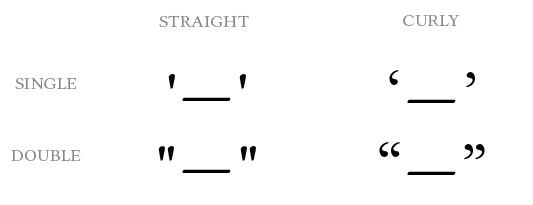
Now, let’s say you have a 350 page novel full of witty dialogue, but you’ve used straight quotes everywhere, and now you want to change them all into curly quotes. Nobody in their right mind would try to change them manually (although I’ve done these things manually far too often before I found out about alternatives).
You could just go ahead and run a search for " and replace it with “, but that would just turn all your quotes into opening quotes.
Here’s a very simple example how you can use regular expressions to help you out. First of all open your search & replace dialogue, either manually or by hitting CTRL+F, or Command-F on Mac.
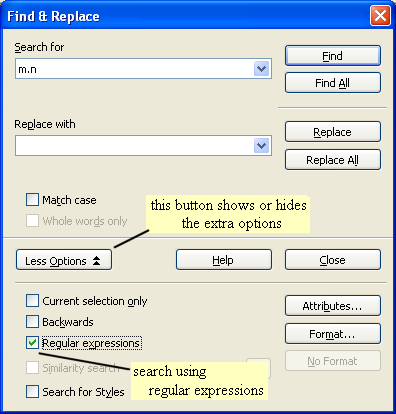
Before we can start with our regular expressions magic in Open Office’s Writer, we’ll have to click on “More Options” and then tick the field “Regular expressions”.
What we’re going to do now is to find all the double quotes at the beginning of a paragraph and turn them into double curly quotes.
To illustrate this process, let’s apply our function to an excerpt from the Hemmingway story A Clean, Well-Lighted Place.
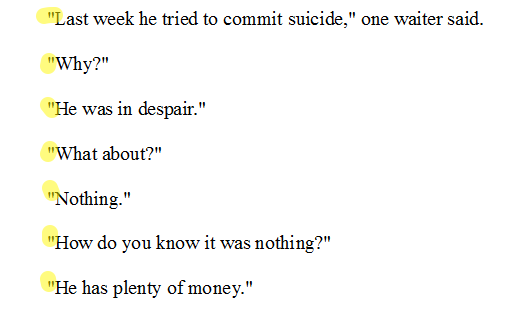
So, all these straight quotes at the beginning of a paragraph should be turned into curly opening quotes. To accomplish this, enter the following into your searchbox:
^"
This regular expression looks for the beginning of a paragraph (^) followed by a double quote.
In your replace box, enter:
“
That’s the opening curly quote. Once you click Replace All the above text will look like this:

In your search box, enter:
"$
The dollar sign stands for the end of a paragraph, so this regular expression looks for a double quote before the end of a paragraph.
In your replace box, enter:
”
And the result:
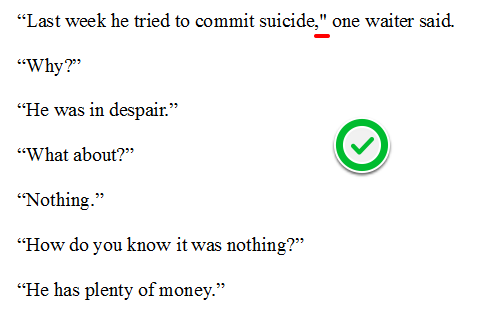
Now all straight quotes at the beginning and end of a paragraph are converted to curly quotes. As you can see, these two simple regular expressions discussed above do not catch all the cases, i.e. if the quote is not at the beginning or end of a paragraph it will not be replaced.
To solve this, you could come up with more advanced regular expressions to find all these quotes inside paragraphs, or you could just use a plain old search & replace, looking for (,") and replacing it with (,”) to deal with this specific situation.
Search & Destroy Empty Paragraphs With Regular Expressions
Another very simple use of regular expressions is to delete empty paragraphs. Sometimes empty paragraphs are automatically created, sometimes you use them while composing a text, but you want to get rid of them later.
Here’s how.
In your search box, enter:
^$
You know both of these signs already. The sign ^ stands for the beginning of a paragraph and $ for the end. So if the end comes directly after the beginning, this means we got an empty paragraph!
In your replace box, write nothing this time, because we want to replace these empty paragraphs with sweet nothingness:
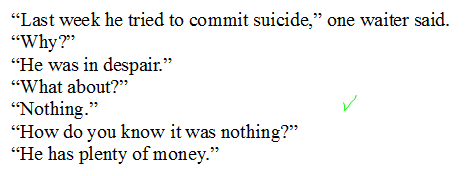
Note: If you want some more space between your lines, it’s far better to use the line-spacing function of your text processing software than empty paragraphs.
Further Study
The above examples are very very simple regular expressions. Regular expressions are much more powerful than that, allowing you to search for complex patterns and replace (parts of) them. Here’s an example from OOOninja:
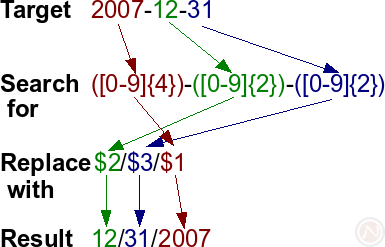
As you see we can use Regex to manipulate any kind of text or numbers, and dissemble and re-assemble them. For example, the red part looks for a 4 digit number sequence, and by wrapping a search in curved brackets, its result can be retrieved through $1 (contents of first bracket), $2 (contents of second bracket), etc. But these things can be scary, so it’s good to take small steps at first.
To find out more about regular expression in Open Office, I recommend this official documentation. For specific uses, it can also be helpful to google and read through forums.
I hope you’ve found this short introduction helpful and got a bit interested in the bewildering world of regular expressions. If you have any questions, don’t hesitate to ask — that’s what the comments are for!
-
img: "Search & Destroy" poster mashup / diagram: oooninja / shirt: by Lasse Havelund via flickR
How To Create Ebooks With Open Source Software: #1 Manuscript Styles
How To Create Ebooks With Open Source Software: #2 Structure & Flow
How To Create Ebooks With Open Source Software: #3 Conversion & Preview
How To Create Ebooks With Open Source Software: #4 The Cover
The Secret Ingredient To Creating Stunning Ebooks With Free Software

 About the author:
André Klein was born in Germany, has grown up and lived in many different places including Thailand, Sweden and Israel. He has produced two music albums, performed and organized literary readings, curated an experimental television program and is the author of various short stories and non-fiction works.
About the author:
André Klein was born in Germany, has grown up and lived in many different places including Thailand, Sweden and Israel. He has produced two music albums, performed and organized literary readings, curated an experimental television program and is the author of various short stories and non-fiction works.
The post Introduction to Regular Expressions For Indie Publishers (Open Office) appeared first on Learn Out Live!.
October 16, 2013
German Short Stories For Beginners

There are many ways to learn or teach German, but my favorite approach is using stories. There are a number of reasons why learning German with stories is so effective, but the best one is this: because it’s fun!
Learning a language can easily become a chore, so anything that takes your mind off the hardship while still staying engaged is a heaven-sent. It’s a bit like “suspense of disbelief”: we need to suspend our knowledge that the content of a movie or book is “just fiction” in order to enjoy it. If we’re constantly reminded that it’s “not real”, we won’t easily identify with the characters and will have trouble experiencing the story from within.
In the same way, by suspending our awareness of the fact that we’re learning a language, we can sometimes get much more out of it. Have you ever had the experience of being so engrossed in a book or a story that you completely forgot everything around you? That’s exactly what I’m talking about.
There’s only one catch: you have to find stories which are both simple enough to be understandable (on your level) and interesting enough to keep you going. And this is often easier said than done.
This is why I’ve collected a few German short stories for beginners in this post. Most of these short stories are from the post-war era. Why? After the second world war, many German authors felt that just like the country had been torn to smithereens, so had the German language, therefore they started writing short stories in a new simplified language, free from the pathos or ideological tendencies of their predecessors.
Turns out these short stories are also a great way to practice German for intermediate learners and even beginners.
Die Küchenuhr, by Wolfgang Borchert
This short story is about a young man who has lost his home and family during a bombing. Through a remaining kitchen clock he remembers the care of his mother and understands his lost family life as a blissful state.
“Die Küchenuhr” is one of the most well-known short stories by Wolfgang Borchert and is often studied in German classes to introduce students to the concept of Trümmerliteratur,
 Read the short story in German here.
Read the short story in German here.
 Read an English translation of the short story here.
Read an English translation of the short story here.
 Additional material: Quizlet to help you understand and practice vocabulary from this short story.
Additional material: Quizlet to help you understand and practice vocabulary from this short story.
Der zufriedene Fischer - Eine Anekdote zur Senkung der Arbeitsmoral, by Heinrich Böll
In this short story by literary Nobel laureate Heinrich Böll, a fisherman and a tourist exchange their views about life and “work ethic”. Written in the middle of the German Wirtschaftswunder (economic boom) in 1963, this short story was questioning the new-found German prosperity but its content is timeless and more valid now than ever.
 Read the short story in German here (including a written exercise prompt).
Read the short story in German here (including a written exercise prompt).
 Read an English translation of the short story here.
Read an English translation of the short story here.
 a short animated LEGO video about this short story, an audio reading (starts at 0:30) via Wattenichsachs, or:
a short animated LEGO video about this short story, an audio reading (starts at 0:30) via Wattenichsachs, or:
Der große Wildenberg, by Siegfried Lenz
Written in 1958 this German short story is about a man who goes to a job interview and gets entangled in the cogwheels of bureaucracy.
 Read the short story in German here.
Read the short story in German here.
 English translation of this short story not available.
English translation of this short story not available.
 an audio reading on Youtube
an audio reading on Youtube
Skorpion, by Christa Reinig
More a parable than a short story, this text deals with a man who feels excluded from society due to his appearance and tries to convince people to accept him while walking through a city.
 Read the short story in German here.
Read the short story in German here.
 English translation of this short story not available.
English translation of this short story not available.
 an audio reading on Youtube
an audio reading on Youtube
Auf der Flucht, by Wolfdietrich Schnurre
Written between 1945 and 1948, this short story by Wolfdietrich Schnurre is about a family fleeing through a barren landscape. Pained by hunger the family is looking for food, and when the father eventually finds a loaf of bred he is forced to evaluate his real motives.
 Read the short story in German here.
Read the short story in German here.
 English translation of this short story not available.
English translation of this short story not available.
 an audio reading on Youtube
an audio reading on Youtube
Even More German Short Stories for Beginners
If you’re looking for even more German short stories for beginners, this PDF contains 16 stories (including some of those mentioned above).
Should these stories still be too difficult, you can also take a look at my book “Café in Berlin” which is a collection of very short German short stories for beginners written in a simplified language and supported by an extended dictionary and comprehension questions. This book is designed as a stepping stone to learning German with authentic literature.
There’s also an animated video for the first and second chapter of this book, complete with German subtitles and exercises.
Which German short stories do you think are good for beginners? Write a comment!
-
photo: Some rights reserved by mikemol
Death By Gaming: A New Murder Mystery For German Learners
Of Swords & Dungeons: An Interactive Gamebook For German Learners
Language Learning Is Not A Contest
3 Reasons Why Video Games Are Underestimated In Language Learning
Learn a Language With Music: Boost Your Memory & Connect The Dots

 About the author:
André Klein was born in Germany, has grown up and lived in many different places including Thailand, Sweden and Israel. He has produced two music albums, performed and organized literary readings, curated an experimental television program and is the author of various short stories and non-fiction works.
About the author:
André Klein was born in Germany, has grown up and lived in many different places including Thailand, Sweden and Israel. He has produced two music albums, performed and organized literary readings, curated an experimental television program and is the author of various short stories and non-fiction works.
The post German Short Stories For Beginners appeared first on Learn Out Live!.
October 11, 2013
3 Reasons Why Online Teachers Fail

Online teaching is still a mystery to many people. How does it work? What are the requirements? Does it pay the bills? Where to start?
There are many websites that promise online teachers a quick and effortless start. I’ve found, however, that making yourself independent from the beginning — if harder at first — pays off much more in the long run, both financially and in terms of personal development.
Over the last few years I’ve written a number of articles on this blog (bundled in my book “How To Teach Online without Selling Your Soul“) about the journey of teaching online for a living. Today I’d like to talk a bit about the reasons why many online teachers eventually give up altogether or cave in to mainstream online teaching platforms that take a big bite out of their salaries.
Running an online teaching business is exactly that: a business — regardless of one’s didactic skills, there are a number of reasons why some online teachers fail where others succeed. Here are a few of the reasons:
1. Online Teachers Fail Because Of Bad Site Design
Most independent online teachers have their own website and domain. The main purpose of an online teacher’s website is to attract new students and transform visitors into clients. It doesn’t matter what subject you’re teaching, whether it’s advanced algebra or Gaelic, your website either works, or it doesn’t.
When I talk about design, I’m not referring to color-harmonies, typesetting and visual styles (although that’s all important). What I mean by design is the mechanics of an online teachers’s website. In that sense, good design is not a matter of taste, it’s a matter of functionality.
Thanks to our free online teachers directory I see a lot of online teachers’ websites every day. Unfortunately, many websites of online teachers suffer from bad design. In other words, they don’t seem to be doing a good job of turning visitors into clients.
It’s very easy these days to create a webpage. Almost too easy, in that it just takes a few clicks to add all kinds of widgets, shmidgets, social media bars, buttons, popups and toolbars until a website becomes completely unusable.
Let’s start from the beginning. A website should connect students or clients with the online teacher.

Think of the website like a portal. It should bring the student directly to you, the online teacher. This is its sole purpose. Everything else on the website should be subordinated to this primary function.
I’m very well aware that an online teacher’s website should showcase the educator’s professional interests, activities, history and many other details around his or her profession, but if you want your website to turn potential visitors into paying clients, all of this information has to be organized in such a way that it doesn’t interfere with the site’s primary function.

Generally speaking, each link leading away from your website already is problematic. Again, of course there will be lots of interesting links which are relevant for students, but they have to be organized in such a way that they don’t distract from the main goal (think about organizing vertically, not just horizontally)
Good Design Reduces Complexity
Let’s start by looking at a general menu or navigation element of a website. As a general rule of thumb: the less options the better. Each option that doesn’t directly contribute to establishing a connection between student and teacher shouldn’t be visible (or at least not on the same organizational hierarchy level).

To help you organize this information, put yourself in the shoes of a potential client. If they are actually interested in taking lessons, they will want to know at least three things: a) who’s the teacher? – b) how much does a lesson cost? – c) how can I contact the teacher?
Think of a potential path a visitor might follow through the site, for example About -> Pricing -> Contact. If your website was a funnel, which part would be the top and which the bottom? Where do you want a visitor to end up? By thinking about these questions, it becomes very easy to organize a menu (or any other information) so that it leads to results.
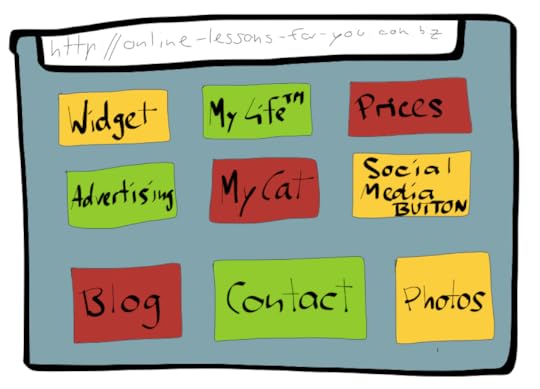
Unfortunately, many online teachers’ websites look like this. The visitor is overloaded with too many options which are not organized along a clear path. Instead of leading a visitor towards a clear goal (such as filling out a contact form for example) prospective clients are scattered or even led away to completely unrelated websites.
How To Build an Online Teaching Website That Works
In general, it doesn’t matter what system you use to build a website. It could be built on Joomla, WordPress or even simple HTML. As long as it’s designed well it will deliver results.
Many people are overwhelmed by the technical aspects at the beginning, but the kind of structural thinking I’ve been speaking about has really nothing to do with the technology or platform a website is built on.
Personally, I really like WordPress, so I’ve written two tutorials on how to build a very basic online teaching website:
10 Steps To Your Online Teaching Website
10 More Steps To Your Online Teaching Website
2. Online Teachers Fail Because They Are “Ungoogleable”
Everyone talks about Social Media these days, and it has become an integral part of running any kind of online business. However, it does not replace the fact that if people can’t find your website on Google (or other search engines) it’s virtually non-existent.
The process of making sure one’s site can be found on Google, Bing, Yahoo, etc. is called search engine optimization or short: SEO. There are a lot of rumors about SEO. Many people think it’s a waste of time, however, as this infographic shows, these opinions are often based on misunderstandings or deceptions.
But what does it actually mean to “be found” on Google? It certainly doesn’t mean showing up on Google results page 300! In fact, as you can see in this graphic below, if your page doesn’t show up on the first Google search results page, traffic is radically shrinking.
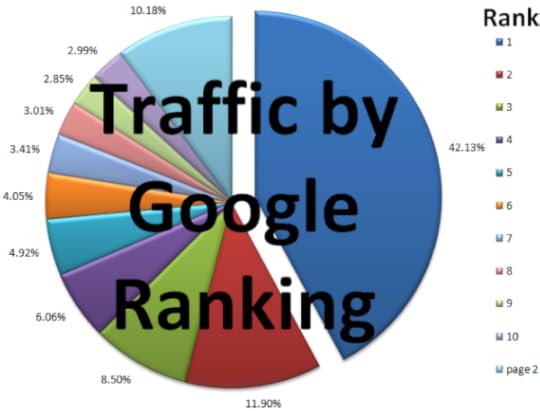
Everything after search results page 3f is equally invisible …
There’s a lot to be said about SEO. I’ve written a very basic introduction here on this blog: SEO How To: Search Engine Optimization: 5 Simple Tips For Beginners
Another great resource for beginners and seasoned search engine optimizers is seobook.com. If you’re running a WordPress blog, also check out this plugin to help you optimize your posts and pages.
3. Online Teachers Fail Because They Don’t Create Content
This is closely related to point two: the more content an online teaching website has, the more it will show up on search engines.
For example, I always recommend that online teachers start a blog, because it not only showcases a teacher’s skills and personality, tells visitors that a site is well-maintained – a blog can also radically increase a website’s visibility on Google and other search engines, if done right.
For example, if there are only three pages on your website and these do not rank well on Google, writing blog posts that target less competitive keywords can be a great way to gain visibility.
Perhaps your website is offering French lessons via Skype, but when people search for “French lessons via Skype” the site only shows up somewhere after page three. What to do? It might be a good idea to find less competitive keywords and keyphrases, and write blog post around them. You might find that it will be much easier to rank higher for specific search phrases such as “French vocabulary for beginners” than your primary keywords.
These keywords may not be directly related, but they will still be relevant! Plus, you can try to target new related phrases with each new blogpost.
You can find related keywords by using Google’s Keyword Planner. Taking a look at monthly search volume and competition will give you a quick idea if it’s worthwhile pursuing a certain search phrase.
Pro-Tip: Look out for so-called “long-tail” keywords. These are very specific search terms which often do not bring a lot of traffic per month but pay off in the long run due to their high relevance. To find these long-tail keywords, start your keyword research from the lowest amount of hits per month and work your way upwards, noting down possible keywords along the way.
[image error]
showing related keywords for “learn french” and a potential long-tail search phrase
-
img: pie chart via seobook, illustration: CC by Rakka
How To Grow Your Online (Teaching) Business Without Becoming a Self-Promoter
The Key To Online Teaching Business: Paying It Forward
Online Teaching Platforms: Why We Don’t (Really) Need Them To Make A Living
How to Become an Online Teacher Without Selling Your Soul
5 Simple Steps to Increase Your Audience Through Better Design

 About the author:
André Klein was born in Germany, has grown up and lived in many different places including Thailand, Sweden and Israel. He has produced two music albums, performed and organized literary readings, curated an experimental television program and is the author of various short stories and non-fiction works.
About the author:
André Klein was born in Germany, has grown up and lived in many different places including Thailand, Sweden and Israel. He has produced two music albums, performed and organized literary readings, curated an experimental television program and is the author of various short stories and non-fiction works.
The post 3 Reasons Why Online Teachers Fail appeared first on Learn Out Live!.
October 3, 2013
Learn a Language With Music: Boost Your Memory & Connect The Dots

Have you ever tried to learn a language with music? Here are some tips and tricks how to get the most out of learning a language with music.
Why Learn a Language With Music?
Music influences us in many different ways scientists are still struggling to understand. Music can lower stress, make us feel happy and energized (or the opposite). Whatever the neurological explanations may be, music works. And it works on multiple levels.
Reclaim Your Earworm And Storm The Castle Of Memorization

Before writing became commonplace, ancient human cultures used to transmit their knowledge from generation to generation orally. As Thomas Mann writes in “Joseph and his brothers” the old stories which later became part of the canon of many world-religions probably first began as “shepherd songs”.
One reason ancient human cultures all over the world used songs is because of the memory-boosting effects of songs and music in general. Just like stories, songs and poems are “sticky” — they stay in our memory much longer because they resonate (figuratively and literally).
For example, there’s a reason why radio and television advertising uses jingles. The melody is used to carry a message. If the melody of a song or a jingle hits the right nerve we consider it an earworm. And then we just can’t get it out of our head, like that infamous Kylie Minogue song.
Earworms are not always pleasant, but we can use their incredible stickiness for our own purposes when we learn a language with music. Just like the trojan horse, music can smuggle new words and phrases beyond the walls of forgetfulness. And when grammar rules and vocabulary lists are long forgotten, the earworm still rambles on.
Learn a Language With Music To Connect the Dots

When we start learning a new language, we begin with learning a few words here and a few grammar rules there. As long as we isolate certain parts of speech we are fine. But once we want to have a conversation and suddenly need to use all of these things together we’re like a novice driver overwhelmed by controlling gas, clutch, brake and shift knob in sync.
When we learn a language with music we can bring the pieces together early on. How does it work?
Reading a word on paper, we see the shapes of its letters and its spelling, but we don’t hear it. We don’t see how it’s being used in context by a native speaker in a natural situation. It doesn’t come with any communicative intent or emotive message.
When we hear a new word in a song, we can derive meaning from it on multiple levels. First of all, there’s the pronunciation, then there’s the larger context of how it’s being used as part of a phrase or verse, and the feeling or idea it communicates.
3 Ways to Learn a Language with Music
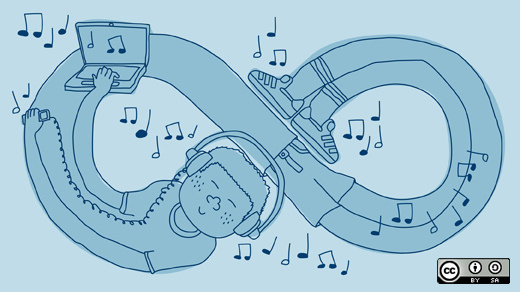
Now that we’ve talked a bit why it works so well to learn a language with music, let’s take a look at how we can use these insights on a daily basis.
1. If you don’t like it, don’t listen to it
The most important part for everyone who wants to learn a language with music is to find songs that you actually like. It sounds obvious, but we can’t really capitalize on the memory–boosting and holistic learning aspects if we can’t stand a certain melody, singer or music style.
In that sense, whatever floats your boat is fine. Some teachers may recommend to look at more classical songwriting and warn you about listening to songs with a lot of slang, but in my opinion the learner’s reaction to the song is more important than the literary quality of its lyrics. And while slang and curse words usually (and luckily?) aren’t part of a language learning curriculum, they are legitimate parts of a language and therefore you will encounter them in songs.
2. Where To Find Music
Depending on what language you are learning, it may be difficult to find songs. Before going out and buying tons of CDs and MP3s take a look around on the open web and see what you like.
YouTube can be a good start for browsing songs in a foreign language. Often there are playlists for keywords such as “Korean music” or “Hebrew songs” and sometimes you even get a video with lyrics so you can read or sing along.
Once you’ve found an artist that you like, you could go and have a look on a site like Spotify or Grooveshark and explore more songs of the same genre. These services usually have “related artists” sections so that might come in handy, as well.
3. How To Learn a Language With Music
There are many ways you can practice a new language with music. Here are only a few ideas:
Listen to the song without looking at the lyrics and write down words you pick up. Don’t worry about catching everything. Just listen attentively and write down what you hear. Then, listen to the song again but now look at the lyrics and see how the words you picked up appear in context.
After having listened to a song a few times, try to translate it into your mother tongue by consulting a dictionary. Depending on the song, you might get some good vocabulary and common phrases out of this. Moreover, you get to learn how the language works when expressing feelings or ideas.
Sing along. This can be a lot of fun and a very effective pronunciation practice. Don’t worry about hitting all the notes — this is about language learning, not becoming the next Pavarotti! Imitate the singer’s pronunciation of single words and phrases. Once you’ve done this a couple of times you’ll be able to sing the song in your head while running, doing the dishes or on the way to work. You might not be able to understand everything, but once a song is committed to memory you’ll find that parts of it will resurface naturally during the day.
-
img: CC by masochismtango, CC by 'No Matter' Project, CC by EssG, CC by opensourceway via flickR
Language Learning Is Not A Contest
How To Quickly Change Dictionaries on The New Kindle Paperwhite
How to Learn German With Stories
3 Reasons Why Video Games Are Underestimated In Language Learning
Through Thick & Thin: Why Languages Are Like Friends

 About the author:
André Klein was born in Germany, has grown up and lived in many different places including Thailand, Sweden and Israel. He has produced two music albums, performed and organized literary readings, curated an experimental television program and is the author of various short stories and non-fiction works.
About the author:
André Klein was born in Germany, has grown up and lived in many different places including Thailand, Sweden and Israel. He has produced two music albums, performed and organized literary readings, curated an experimental television program and is the author of various short stories and non-fiction works.
The post Learn a Language With Music: Boost Your Memory & Connect The Dots appeared first on Learn Out Live!.
September 27, 2013
How To Quickly Change Dictionaries on The New Kindle Paperwhite

I’ve already talked a lot about Kindles and dictionaries on this blog. Whether it’s using custom dictionaries on iOS devices such as iPad or iPhone or on older devices such as the Kindle keyboard, I absolutely love this feature both as a teacher and learner because integrated dictionaries can be very powerful tools for language learning.
Two weeks ago we talked about the new Kindle Paperwhite and its additional features for language learners (such as instant translations and the vocabulary builder). And now, thanks to Reddit user GabrielBetteredge I found out that the custom dictionary option itself has been improved as well.
So far, it had always been possible to install multiple custom dictionaries to your Kindle device. But if you’re accustomed to reading books in multiple languages, switching from one dictionary to another has been cumbersome. For example. with the Kindle Keyboard you had to first close the book, click on Menu, then click on Menu again, choose “select primary dictionary”, click okay, close the menu and open the book again (seven steps, that’s right).
Now, changing dictionaries has become a lot easier.
While looking up a word on the new Kindle Paperwhite (by tapping on it), you’ll see a little popup with a headline containing the name of your current dictionary. Next to the dictionary’s name, there’s a little arrow.
By tapping the arrow, you get a list of all your currently installed dictionaries:
UPDATE: this feature is not just available on the new Kindle Paperwhite, it even works on the original Paperwhite, due to the Firmware update.
While it’s probably true that most people will not switch their dictionary every five minutes, I can imagine a few situations where this feature might come in handy. For example, non-native English speakers will sometimes need a translation to their own language (English-French, English-Spanish, etc.) while other times the standard English-English dictionary will suffice.
Also, language learning students who use their Kindle to devour a lot of course-required reading in multiple languages, will be grateful to just change the dictionary with two clicks instead of seven!
-
screenshots: GabrielBetteredge / photo: Some rights reserved by Moridin_ via FlickR
How To Add a German-English Dictionary To Kindle on Your iPad or iPhone (iOS)
Boost Your Vocabulary with The New Kindle Paperwhite Flashcards Feature
Use Your Kindle To Learn A Foreign Language
How to Learn German With Stories
Learn German On Kindle With Free Books

 About the author:
André Klein was born in Germany, has grown up and lived in many different places including Thailand, Sweden and Israel. He has produced two music albums, performed and organized literary readings, curated an experimental television program and is the author of various short stories and non-fiction works.
About the author:
André Klein was born in Germany, has grown up and lived in many different places including Thailand, Sweden and Israel. He has produced two music albums, performed and organized literary readings, curated an experimental television program and is the author of various short stories and non-fiction works.
September 24, 2013
5 Ways To Learn German For Free

There are as many ways to learn German as there are individuals. Every day new sites are popping up that promise to help you learn German quickly and for free. But which ones are worth signing up for? Which ones are a waste of time? Here’s a selection of free German learning sites and services that I’ve tested as a German teacher and life-long language learner.
1. Learn German With Duolingo
Many people are talking about Duolingo on language learning forums and communities these days. It works similarly to programs like Rosetta Stone, showing the learner simple questions and writing or speaking prompts. But is it a good way to learn German?
First of all, working through Duolingo does not replace a full-fledged German course, since it gives virtually no explanations about why something is correct and why it isn’t. The main approach here is to use English as a bridging tongue and learn by trial and error.
Having said that, Duolingo is great for getting started for absolute beginners. It will help you learn a few basic phrases and (depending how far you get) make your first forays into the intricacies of German grammar.
How does it work?
You sign up for a free account and start learning on your laptop, tablet or smartphone. The software asks you simple questions. You have three hearts. Make a mistake and you lose one. Lose all hearts and you have to start the “level” again from the beginning.
Duolingo features one of the best implementations of gamification in language learning I’ve ever seen, going far beyond mere “badges”, but using video game metaphors of “three lives” and having to complete former levels before unlocking higher levels. If you’re a German learner who likes video games, you should definitely check it out!

one life lost, two more to go …
If you prefer deeper and decelerated approaches, read on.
2. Deutsche Welle, Simply the Best Free German Resource

Every German learner should have heard about the wealth of learning materials which is the Deutsche Welle‘s German learning program. Deutsche Welle (German wave) is Germany’s international broadcaster; it’s state-funded, and therefore free from advertising or sketchy ways to get at your wallet.
Deutsche Welle offers so much for German learners that it can be overwhelming at first. There are free videos, audios, texts, exercises, vocabulary lists and more, geared at every level of German learner.
A good starting point for exploring this treasure trove is to go to the home page and select your level.
In my practice as a German teacher the Deutsche Welle materials have been immensely helpful, but they are also great for self-study.
Here is only a small selection of what they offer:
Deutsch Interaktiv is the Deutsche Welle’s self-study course, covering the very basics from A1 to A2, complete with audio, video, 750 interactive exercises and more than 7,000 words. You can check out the course as a guest but you need to create a free account in order to save your progress.
Langsam gesprochene Nachrichten offers slowly spoken daily news in German. Some of my students subscribed to the feed via iTunes and loved to listen every day on their iPods while jogging or commuting. Each episode comes with a full transcript.
Top-Thema mit Vokabeln is one of my favourite features of the Deutsche Welle. This section offers short articles focusing on current events with vocabulary and exercises. Each article comes with audio, transcript and downloadable PDF. If you prefer video to audio, there’s a sub-section called Video Thema which offers even more exercises and vocabulary.
Deutsch im Fokus offers weekly articles about German language and daily life in Germany, complete with vocabulary, exercises and audio.
This is just the tip of the iceberg. Deutsche Welle has much more free materials for German learners, from its very own telenovela to games. Navigating this ocean of content can be tricky at first. I would recommend to just browse until you find something that tickles your fancy and then take it from there.
3. Dict.cc – The Best Online German Dictionary

Not specifically a learning resource per se, this free German dictionary is by far one of the best I’ve ever seen. It’s not bloated with advertising and clicking schemes, the design is efficient and the translations are brilliant, covering many different variations and idiomatic usages. According to the founder dict.cc “is more than just a dictionary – it’s the attempt to create a platform on which users from all over the world can exchange their knowledge.” It’s a bit like Wikipedia, in that everybody can participate, suggest, correct and discuss translations, resulting in one of the best resources for English-German and German-English translations (the site offers other language pairs, too, but I haven’t tested these in-depth).
This dictionary comes with an integrated free vocabulary trainer, pocked edition, Android and iPhone app and should be an essential part of every German learner’s toolkit.
4. Learn German By Reading Online Articles
If you like browsing the web and reading articles in German but find it cumbersome to look up and memorize new words, take a look at Lingua.ly. Although the service officially is advertised only for learning Spanish, English, French, Hebrew and Arabic, I’ve found that it works for learning German, too.

How does it work? You register for free and install the free Chrome extension. Then, whenever you are reading a German article and stumble over an unknown word, you can get an instant translation and pronunciation by double-clicking it. After you’ve done that a few times, the Chrome extensions saves these words in a library and keeps checking every few days if you still know them.
The pile of words you have to practice is called “inbox” and you get a white-on-red notification bubble right next to your address bar, always urging you to complete all your challenges and keep your inbox at 0.
NOTE: This tool recommends articles based on a learner’s vocabulary level, but so far it doesn’t work for German, perhaps they’ll implement it in the future. But for now, looking up new words and practicing them on a continual basis is still a great way to memorize vocabulary and improve text comprehension skills.
I’m using this tool at the moment to expand my Hebrew vocabulary. My inbox is at 141 words … gotta complete those challenges.
5. Tom’s Deutschsseite: a great resource for German Grammar
As an online teacher, I’ve always been looking for good resources and exercises for German grammar study. One of my favorite sources has become Tom’s Deutschseite. Thomas Höfler, the author of the website, put more than 1500 hours of work into this project, resulting in countless practice and explanation pages. And yet, he chose to make it all available for free!
I’m not sure that the site is a good way to study German grammar in a linear way like a textbook, but if you need help with specific topics, Toms pages are invaluable.

The design of the site may be in need of an upgrade, but don’t let that distract you from the content. Each grammar topic comes with solid explanations, excercise sheets (with solutions) and summaries in PDF format.
Tom also has resources for vocabulary and text study, but I haven’t checked these out, yet.
Take a look at the Table Of Contents for a complete list of topics.
Update: Even More Free German Learning
Another good resource for learning German in bite sized bits is my colleague Kirsten Winkler’s project Deutsch Happen project. Founded in 2005 she has produced a considerable amount of free podcasts, videos and articles about various topics ranging from culture and idioms to everyday German language.
-
blackboard image: Some rights reserved by GretchensFrage
What are your favourite free resources for learning German? Tell us in the comments, below!
How to Learn German With Stories
How Not To Learn German Quickly
Yet Another Free Picture Book For German Learners (And Some Ruminations About Audio-Augmented Ebooks)
Learn German With Adventure Games
How To Add a German-English Dictionary To Kindle on Your iPad or iPhone (iOS)

 About the author:
André Klein was born in Germany, has grown up and lived in many different places including Thailand, Sweden and Israel. He has produced two music albums, performed and organized literary readings, curated an experimental television program and is the author of various short stories and non-fiction works.
About the author:
André Klein was born in Germany, has grown up and lived in many different places including Thailand, Sweden and Israel. He has produced two music albums, performed and organized literary readings, curated an experimental television program and is the author of various short stories and non-fiction works.
September 19, 2013
How To Create Doodle Videos For Language Teaching
We don’t learn a language only by reading, or only by listening. Learning a language is a multi-sensory process. Looking at a text or listening alone is not enough. We need to listen, speak, read, write and observe in order to acquire a new language.
In German, we say that that a good teacher should always make his lessons “anschaulich”, often translated as “vivid” (lively, from lat. videre, to live). But what the word really means is to present new material in such a way that it can be easily grasped by “looking at” (anschauen) it.
This is not a new idea. For centuries teachers have been using blackboards (and later whiteboards) to illustrate and visualize new concepts for learners. Through the use of modern digital tools, however, we have gained new possibilities.
What Are Doodle or Scribble Videos?
In the last few years, many companies have been using doodle videos as a promotional tool, creating demo videos or describing a new service. But what is a doodle video? In case you’ve never seen one before, a doodle video generally shows a hand (from above) writing and drawing things on paper.
While these kinds of videos may already have exhausted their novelty value in marketing, they still can be a powerful tool for teaching languages.
How To Make a Doodle Video?
A few years ago I was helping a non-profit organization build a live-video broadcasting studio. One part of the broadcast was showing an instructor’s hand (from above) drawing diagrams while he was talking. In order to achieve the desired effect, we had to bolt a camera onto the ceiling and keep moving lights around for hours.
In other words, this approach is not very practical for teachers or other individuals who quickly want to visualize something.
Luckily, there’s “an app for that”. It’s called VideoScribe, and it lets you quickly create doodle videos, even for free.
How Can I Create Doodle Videos With VideoScribe?
First of all, you need to register at videoscribe.tv. Signing up for an account is free. Then you need to download the software, VideoScribe Desktop, which you can use freely for seven days. Doodle videos created with a free account are branded (a little logo in the lower right) and a short outro, but for many teaching purposes, this will not be a problem. Premium licenses cost £16 montly, £119 yearly, or £398 forever.
After downloading the software you can start your first project.
Here’s an overview of the main screen:
First of all, you can add an image doodle. You can either pick one of the prepared doodles from the software’s library, or import your own from your harddrive or even directly from the web. The software works with vector images, so it easily integrates graphics from sites such as openclipart.org.

After choosing an image and placing it on the stage, we can preview how it is drawn:

In the same manner, we can add text to the stage and preview:

Adding Voice-Over and Publishing Your Doodle Video
This tool has many features, and although I figured most of it out within a few hours, beginners struggling with camera control and sequencing may find it helpful to take a look at the tutorials section.
Another helpful option is that you can directly record your voice into the application. By looking directly at the animations while recording, it may be easier to time your voice-over. (Personally, I prefer to do the audio first and then time the video, but that’s just me.)
After your video is complete, you can save it to your computer or publish it directly on YouTube, Facebook or Dropbox.
Usage and Examples Of Doodle Videos For Language Teaching
As I’ve written above, the more senses we use while learning a language, the better. By creating a simple doodle video with voice we can have multiple effects in language teaching. If we take a look at the example of the coffee cup, we communicate on three levels simultaneously: the visualization of the object, the word for it, and the pronunciation.
Curious how it all comes together? I’ve recently created two videos from my new book for German learners for beginners. The videos come with subtitles for additional learning benefits.
Learn German with Stories: Café in Berlin (Chapter 1)
Learn German with Stories: Café in Berlin (Chapter 2)
-
images: VideoScribe
Disclaimer: this post contains two affiliate links
The Quest For The Perfect Whiteboard
How To Optimize The Lesson Preparation Process In Online Teaching
The Flipped Office: Work at Home, Relax Outside
Online Teaching & Learning Tools: What You Need to Succeed
10 Steps To Your Online Teaching Website

 About the author:
André Klein was born in Germany, has grown up and lived in many different places including Thailand, Sweden and Israel. He has produced two music albums, performed and organized literary readings, curated an experimental television program and is the author of various short stories and non-fiction works.
About the author:
André Klein was born in Germany, has grown up and lived in many different places including Thailand, Sweden and Israel. He has produced two music albums, performed and organized literary readings, curated an experimental television program and is the author of various short stories and non-fiction works.












